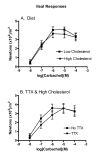Increased cholinergic contractions of jejunal smooth muscle caused by a high cholesterol diet are prevented by the 5-HT4 agonist--tegaserod
- PMID: 16504074
- PMCID: PMC1434748
- DOI: 10.1186/1471-230X-6-8
Increased cholinergic contractions of jejunal smooth muscle caused by a high cholesterol diet are prevented by the 5-HT4 agonist--tegaserod
Abstract
Background: Excess cholesterol in bile and in blood is a major risk factor for the respective development of gallbladder disease and atherosclerosis. This lipid in excess negatively impacts the functioning of other smooth muscles, including the intestine. Serotonin is an important mediator of the contractile responses of the small intestine. Drugs targeting the serotonin receptor are used as prokinetic agents to manage intestinal motor disorders, in particular irritable bowel syndrome. Thus, tegaserod, acting on 5-HT4 receptor, ideally should obviate detrimental effects of excessive cholesterol on gastrointestinal smooth muscle. In this study we examined the effect of tegaserod on cholesterol-induced changes in the contractile responses of intestinal smooth muscle.
Methods: The effects of a high cholesterol (1%) diet on the in vitro contractile responses of jejunal longitudinal smooth muscle from Richardson ground squirrels to the cholinergic agonist carbachol were examined in the presence or absence of tetrodrodotoxin (TTX). Two groups of animals, fed either low (0.03%) or high cholesterol rat chow diet, were further divided into two subgroups and treated for 28 days with either vehicle or tegaserod.
Results: The high cholesterol diet increased, by nearly 2-fold, contractions of the jejunal longitudinal smooth muscle elicited by carbachol. These cholinergic contractions were mediated by muscarinic receptors since they were blocked by scopolamine, a muscarinic receptor antagonist, but not by the nicotinic receptor antagonist, hexamethonium. Tegaserod treatment, which did not affect cholinergic contractions of tissues from low cholesterol fed animals, abrogated the increase caused by the high cholesterol diet. With low cholesterol diet TTX enhanced carbachol-evoked contractions, whereas this action potential blocker did not affect the augmented cholinergic contractions seen with tissues from animals on the high cholesterol diet. Tegaserod-treatment removed the effects of a high cholesterol diet on neuronal muscarinic receptors, as the potentiating effect of TTX on carbachol-elicited contractions was maintained in these animals.
Conclusion: A high cholesterol diet causes significant changes to cholinergic neurotransmission in the enteric nerves of the jejunum. The mechanisms by which these effects of cholesterol are reversed by tegaserod are unknown, but relate to removal of an inhibitory effect of cholesterol on enteric nerves.
Figures




Similar articles
-
Effects of tegaserod on bile composition and hepatic secretion in Richardson ground squirrels on an enriched cholesterol diet.Lipids Health Dis. 2006 Jun 22;5:15. doi: 10.1186/1476-511X-5-15. Lipids Health Dis. 2006. PMID: 16792807 Free PMC article.
-
Regional gastric contractility alterations in a diabetic gastroparesis mouse model: effects of cholinergic and serotoninergic stimulation.Am J Physiol Gastrointest Liver Physiol. 2004 Sep;287(3):G612-9. doi: 10.1152/ajpgi.00431.2003. Epub 2004 Apr 23. Am J Physiol Gastrointest Liver Physiol. 2004. PMID: 15107299
-
Fibre-free diet leads to impairment of neuronally mediated muscle contractile response in rat distal colon.Neurogastroenterol Motil. 2006 Dec;18(12):1093-101. doi: 10.1111/j.1365-2982.2006.00847.x. Neurogastroenterol Motil. 2006. PMID: 17109693
-
Review article: effects of the 5-HT3 receptor antagonist alosetron on neuromuscular transmission in canine and human intestinal muscle.Aliment Pharmacol Ther. 1999 May;13 Suppl 2:39-47. Aliment Pharmacol Ther. 1999. PMID: 10429739 Review.
-
Carbon monoxide is an endogenous hyperpolarizing factor in the gastrointestinal tract.Neurogastroenterol Motil. 2004 Apr;16 Suppl 1:81-5. doi: 10.1111/j.1743-3150.2004.00480.x. Neurogastroenterol Motil. 2004. PMID: 15066010 Review.
Cited by
-
Spasmogenic Activity of the Seed of Terminalia chebula Retz in Rat Small Intestine: In Vivo and In Vitro Studies.Malays J Med Sci. 2011 Jul;18(3):18-26. Malays J Med Sci. 2011. PMID: 22135597 Free PMC article.
-
Effects of tegaserod on bile composition and hepatic secretion in Richardson ground squirrels on an enriched cholesterol diet.Lipids Health Dis. 2006 Jun 22;5:15. doi: 10.1186/1476-511X-5-15. Lipids Health Dis. 2006. PMID: 16792807 Free PMC article.
-
Characteristics of deslanoside-induced modulation on jejunal contractility.World J Gastroenterol. 2012 Nov 7;18(41):5889-96. doi: 10.3748/wjg.v18.i41.5889. World J Gastroenterol. 2012. PMID: 23139604 Free PMC article.
-
n-3 polyunsaturated fatty acids in the maternal diet modify the postnatal development of nervous regulation of intestinal permeability in piglets.J Physiol. 2011 Sep 1;589(17):4341-52. doi: 10.1113/jphysiol.2011.214056. Epub 2011 Jul 11. J Physiol. 2011. PMID: 21746785 Free PMC article.
References
-
- Portincasa P, Di Ciaula A, vanBerge-Henegouwen GP. Smooth muscle function and dysfunction in gallbladder disease. Curr Gastroenterol Rep. 2004;6:151–162. - PubMed
-
- Azzaroli F, Mazzella G, Mazzeo C, Simoni P, Festi D, Colecchia A, Montagnani M, Martino C, Villanova N, Roda A, Roda E. Sluggish small bowel motility is involved in determining increased biliary deoxycholic acid in cholesterol gallstone patients. Am J Gastroenterol. 1999;94:2453–2459. doi: 10.1111/j.1572-0241.1999.01375.x. - DOI - PubMed
-
- Hardison WG, Tomaszewski N, Grundy SM. Effect of acute alterations in small bowel transit time upon the biliary excretion rate of bile acids. Gastroenterology. 1979;76:568–574. - PubMed
Publication types
MeSH terms
Substances
LinkOut - more resources
Full Text Sources

